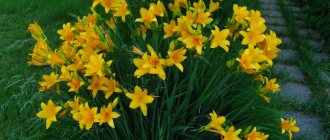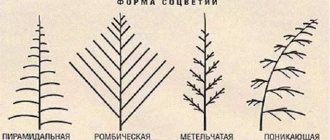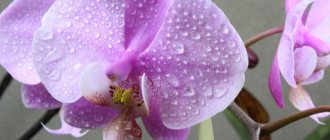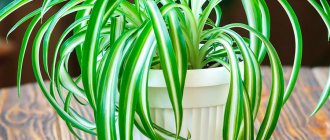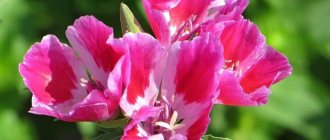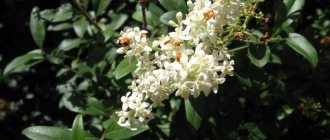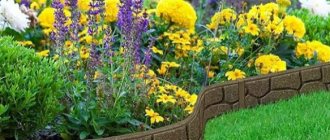|
There is probably not a single gardener who does not know about daylilies. They can be seen both in grandmother’s front gardens and in modern gardens. They say about it: “the flower of an intelligent lazy person,” “planted and forgotten.” Flower growers tell each other myths that if daylilies are fed, they will not bloom. This is all wrong!
The original appearance of the daylily has changed beyond recognition. Modern hybrids require more careful attention, but they will not cause great difficulties. In a short growing season, they should grow green mass, form flower stalks, bloom with gorgeous flowers and set seeds (if pollination has taken place). And our winters! This is a huge stress for hybrid varieties.
The fact is that most modern hybrids come from the southern states of America. In a word, these overseas sissies simply need our help so that they can fully reveal all their gardening qualities in the difficult conditions of Central Russia. With just six right steps, you can grow this beautiful perennial in your gardens without much effort.
Caring for daylilies after planting in open ground
Regular care of plants after planting consists of watering, loosening the soil and removing weeds.
In the warm season, actively growing and flowering perennials require a lot of water. If daylilies are thirsty, this can be noticed by fading foliage, failure to form, or dropping buds. Perennials respond excellently to additional air humidification in summer.
Therefore, daylilies can be planted near ponds or use very fine sprinkling:
- In hot weather, daylilies are watered abundantly, so that the soil under them gets wet by 20–30 cm, that is, to the depth of the root system.
- If the summer is not hot, you can reduce the frequency of watering, but you need to monitor the standing of the foliage.
The best time to water daylilies is early morning or evening, when there is no risk of sunburn on the flowers.
With proper planting and care, daylily flowers, as in the photo, appear in the same summer. In the first year, the plants are not additionally fed. The application of complex fertilizers for flowering ornamental crops begins next spring. When choosing a product, it is better to give preference to formulations with a moderate nitrogen content, which causes the growth of foliage to the detriment of flowering. During the summer, perennials are fed twice, and closer to autumn, the plants receive potassium-phosphorus fertilizers to better prepare for winter.
The plants are frost-resistant, but may suffer when there is too little snow on the site. Therefore, in snowless winters, it is better to cover daylilies with spruce branches, pine needles, straw and other available materials. As soon as the massive melting of snow begins, daylilies are released, otherwise blight develops on the root collars of the plants.
The best time to plant daylilies on the site
Daylilies are peculiar long-livers. The most beautiful flowers, forming clumps decorated with multi-colored corollas, they can grow for up to one and a half decades without replanting. This should be taken into account when choosing a place for plants in the garden, and you should also know that flowering will be at its most lush only for 5–7 years. Then flower stalks appear less frequently among the dense foliage, and the flowers on them are much smaller than before. Therefore, every few years the plants are replanted, dividing the mature perennials.
The unpretentious culture easily tolerates this procedure from early spring to autumn. But planting daylilies in the ground in the spring always goes without complications, the divisions quickly take root and grow, blooming in the same season.
Spring weather is changeable, and if there is a danger of frost, it is better to postpone planting. Planting material purchased or obtained after dividing your own plants can be stored for about a month, burying the root system of the plant in sand, peat-sand substrate, or transferring it with a damp rag. The leaf blades of daylilies are cut by half or a third to reduce the plant’s need for moisture.
If the summer is not hot, and it is possible to create comfortable conditions for daylilies when planting them in the ground, as in spring, nothing prevents you from decorating the garden until the fall. But when planting in autumn, there is a risk that the plants will not have time to take root well, and next year, if they survive, they will be very weakened.
Common mistakes and recommendations
When growing daylilies, gardeners often make mistakes regarding the application of fertilizers. This leads to a deterioration in the appearance of the crop and a lack of flowering. To avoid this, you should follow these recommendations:
- Alkaline agents reduce the acidity of the soil, but are not suitable for neutral ones. Before applying fertilizers, it is necessary to determine the pH of the soil.
- The composition of the product is selected in accordance with the development phase.
- Be sure to follow the dosage.
- Organics should not be used during or after flowering.
- Root fertilizers are applied only to moist soil, carefully so that the granules do not fall on the leaf rosette and cause burns.
- When spraying, try to cover the entire plant, especially the lower part of the leaves.
- The frequency of activities depends on the soil. Fertile soil will require less fertilizer.
The right time at the beginning of the season plays an important role. Fertilize the plant at the moment when the threat of frost has completely passed. After the procedure, the daylily grows quickly; damage to young shoots will delay flowering time.
Types and varieties of daylily with photos and names
Natural views
Natural types of daylilies absolutely all have a spectacular appearance, which is why they are so popular among gardeners. And such flowers are also distinguished by their low maintenance and unpretentiousness. Also, such plants are resistant to diseases and harmful insects, they are drought-resistant and tolerate waterlogging, and these flowers are also durable. The most popular types are red daylily, lemon yellow, yellow, Du Maurier and Middendorff. Description of several natural species:
Daylily orange
Sharply curved dark green rigid leaf plates reach 30 mm in width. The height of the branched peduncles in the upper part is about 100 centimeters. The diameter of the asymmetrical flowers is about 12 centimeters, in the middle they are orange with a brownish-reddish tint, they have no smell. Flowering occurs in July. Cultivated since 1890.
Lemon yellow daylily
This species can be found in nature only in Central China. The shape of the flower is very similar to the white lily and differs in its night flowering. The height of the bush is about 0.8–0.9 m. Tall peduncles branch in the upper part. The flowers have a pleasant and strong scent, they reach 14 centimeters in length and 12 centimeters in width. Flowering occurs in the second half of summer and lasts about 40 days.
Daylily Dumortier (wolfswort)
It can be found in nature in Japan, the Far East, Northeast China and Korea. The height of the compact bush is about 0.7 m. The width of the rich green leaf blades is about 20–25 mm. Peduncles are located at the level of leaf blades. Dense inflorescences consist of 2–4 wide open orange-yellowish flowers. in diameter reaching 5 centimeters. This species is often used by breeders in their work. Cultivated since 1830.
Garden daylily or hybrid daylily
This is a generalized name for hybrid varieties; today there are more than 60 thousand of them. Breeders from Australia and America put the most work into creating such varieties; they created species that differ in flower shape, presence or absence of smell, flowering time, height and color. At the same time, flowers can be painted in a variety of colors and shades. Garden daylily has a complex and rather voluminous classification, in which such flowers are divided according to the length of the peduncle, the size and shape of the flower, color, flowering time, type of vegetation and many other characteristics, however, this scientific work is mostly necessary for specialists, and not necessary for a simple gardener study it. Popular types and varieties of hybrid daylily:
Daylilies group double
Double daylilies, which have additional perianth petals. All available varieties are highly decorative. Eg:
a) Double Cutie . The flower reaches 10 centimeters in diameter. Their throat is green, and their petals are the color of chartreuse. Flowering mid-early.
b) Double Dream . The bush reaches a height of 0.6 m, the leaf blades are basal. The diameter of the flower is about 12 centimeters, apricot-colored petals, dark orange throat.
c) Double Red Royal . Large dark red flowers, their petals are similar to royal velvet. The flowers have an unusual shape. So, they have large outer petals, and inside there is an openwork rosette consisting of smaller petals. One bush can grow up to 30 flower stalks. At the same time, up to 10–20 flowers grow on one peduncle. This variety is re-blooming.
Daylilies spiders (arachnids)
This includes varieties whose flower segments are slightly longer than wide and have a shape similar in appearance to a spider. Varieties:
a) Helix . The large spider has a green throat; this color gradually changes to the yellow color of the petals, and their tips are dark crimson. This flower looks very impressive.
b) Arms to Haven . The throat color of this giant is greenish-yellow, and the long petals are colored red-purple. The flowering is lush. The bush reaches a height of 0.9 m. From 16 to 20 flowers grow on one peduncle.
c) Free Healing . A fairly large spider, yellow-cream in color, with a red throat. The petals are thin and very elongated. Up to 45 flowers can grow on a peduncle.
Fragrant daylily
Includes plants of various shapes, sizes and colors. The flowers are very decorative and have a pleasant aroma. Varieties:
a) Apple Spring . The light pink petals have a yellowish-green edge that is heavily ruffled. The flower reaches 15 centimeters in diameter. The height of the peduncle reaches 0.65 m; about 28 fragrant flowers can grow on it.
b) Ode to Faith . The central stripe of the petal is colored rich yellow with a pinkish tint. The edge of the petals is golden corrugated. The throat is green. The peduncle reaches a height of 0.84 m, the flowers have a delicate scent and a diameter of about 15 centimeters.
c) Deciduous daylily Stella do Oro . The corrugated flowers are funnel-shaped, they are fragrant and dark yellow in color, reaching 7 centimeters in diameter. The flowering is lush and can be observed throughout the summer. This variety has received a large number of awards from the American Daylily Society. It can be cultivated in the garden and as a border plant, and can also be grown at home.
White daylilies
Among the numerous varieties and forms of daylily, there are those that can be conditionally called white. For example:
a) Apple Blossom White . A yellowish-white flower with strongly corrugated petal edges. It reaches a height of 0.83 m; the peduncles have 2 branches with 25 buds.
b) Ruffled Parchment . The ruffled white flower fades from creamy white to yellow at the throat. The diameter of the very fragrant flowers is about 13 centimeters, the height of the peduncle reaches 5 centimeters.
c) Granny Smith . The petals are almost white, they have corrugated green edges.
It is interesting that there is no pure white daylily either among the natural species and varieties or among the hybrid ones. In this regard, experts coined the expression “near white,” which translates as “almost white.” In varieties and species that are called almost white, the petals have a very light melon, lavender, cream, pink or yellow color.
At the moment, experts are working to increase the diameter and doubleness of the flowers, as well as to increase the corrugation of the petals. At the same time, daylily is a very good material to work with, so very soon new spectacular varieties and forms may appear in large quantities.
Fertilizers for lilies
Organic fertilizers restore the soil because microorganisms feed on organic matter. If there are plant or animal remains in the soil, bacteria digest them and release substances that feed the plants. This process takes longer, but the quality of the soil is better: it is loose, retains moisture, and has a lot of nutrients. The problem is that, apart from plant organic matter, many gardeners have nothing else to add to the soil, since it is expensive to buy manure or droppings, but they don’t have their own.
Humus is leftover cow manure or chicken droppings.
The content of free ammonia is much less than in the fresh substance. Humus is added in liquid form to speed up the decomposition process and allow nutrients to reach the roots faster. To do this, make depressions between the bushes and pour in a solution: a third of a bucket of humus, the rest is water.
Compost also takes time to mature naturally. This takes from 9 to 18 months. To prepare compost, weeds or green manure, kitchen waste, manure, chicken droppings and soil are used. To feed daylilies, in the fall, take last year’s compost from a pile and dig it in with the top layer of soil. You can combine it by adding phosphorus and potassium fertilizers to the compost.
An ash solution is most suitable for feeding daylilies in the fall. The content of potassium and phosphorus in ash is the highest compared to other organic substances. In addition, there is calcium, which affects the growth and survival of plants.
Calcium accelerates the metabolism of shrubs, due to which the entire plant develops harmoniously. The rich composition of microelements helps strengthen the immune system; plants tolerate wintering well without shelter and begin to grow early in the spring.
It is better to incorporate organic matter into the soil in the fall. Over the winter they have time to decompose, and in the spring the plants receive ready-made food. In addition, the physical qualities of the soil are improved. Organic matter can be added once every 2-3 years. The rest of the time, use mineral complex fertilizers.
Mineral fertilizers
There are many manufacturers that produce mineral compositions for ornamental plants. These are Kemira, Agricola, Lush Flowering, Buoy fertilizers and others. There are universal mixtures that are suitable for flowers and garden crops:
- Nitrophoska is a complex mixture containing nitrogen, potassium and phosphorus;
- Azofoska;
- Azophos;
- Ammophos.
You can mix the nutrients for your flowerbed yourself using one-component formulations: superphosphate, potassium sulfate, urea, potassium magnesium, potassium salt or potassium chloride.
It is necessary to correctly formulate the mixtures with which to feed daylilies after flowering and in the spring. To fertilize the soil in spring, you need a full range of elements, including nitrogen. Therefore, urea or ammonium nitrate is scattered on the ground. With melt water, fertilizers reach the roots and stimulate the growth of shoots and greenery. Nitrogen affects the immunity of lilies.
Potassium fertilizing is necessary during the formation of buds and during flowering. Potassium increases the lifespan of the peduncle, affects the brightness of shades and the size of the flower.
Potassium is one of the elements that daylilies are fed with in August, as it increases the winter hardiness of plants. If the plant has managed to stock up on food, it will better withstand temperature changes and stagnant water. It happened that during spring floods the garden was completely flooded, the root system was under water for some time without oxygen and, nevertheless, the plant survived and bloomed on time.
Superphosphate is used as phosphorus additives, which dissolves faster and reaches the plants. It is a more efficient fertilizer in terms of speed. There are long-lasting substances containing phosphorus. This is phosphate rock.
It is placed in the ground before frost, because partial dissolution takes time - at least a month. In the spring, when it is urgent to activate the root system, there is no time to wait, because due to a lack of phosphorus, the plant will begin to bloom later and will be weaker, since the absorption of potassium and nitrogen is impaired.
Phosphorite flour is used once every 3 years. To dissolve it, the soil reaction must be acidic or slightly acidic, therefore this type of fertilizer is not suitable for neutral or alkaline soil. Phosphates form insoluble substances with alkaline elements and phosphorus will not enter the plants.
Video: Daylily - cultivation, care and diseases
In this case, it is difficult to determine the cause of the nutrient deficiency, since the fertilizer was applied, but was not used for its intended purpose. Due to the lack of one nutritional component, nitrogen and potassium starvation develops.
It will not be easy for an inexperienced gardener to figure it out, so you first need to check the acidity of the soil in a flower bed with daylilies. This can be done with vinegar, dripping it onto a handful of soil. If a hissing sound is heard and air bubbles are visible, it means the soil contains carbonates and the reaction is neutral or alkaline.
Homemade products
Nutritious infusions are mainly made from weeds, for example: tansy, sweet clover, sedge, reed, wild mustard, comfrey, nettle, chamomile, dandelion, clover and wormwood. This composition contains a high concentration of beneficial microorganisms, nitrogen and other macro- and microelements necessary for the full development of a flowering crop. It is logical that the composition will depend on the components used.
Technology for making home remedies:
- The plastic container is approximately 2/3 filled with pre-chopped weeds. It is important that there are no seeds on them.
- Fill the plants with water, leaving a little space as the plants will increase in volume.
- To stimulate the fermentation process, add 1 tbsp to the composition. Urea (approximately 50 liters of water).
- The container is covered with a lid, but it is also important to arrange holes for gases to escape.
The covered container is left in the sun for 7-14 days, the composition must be stirred periodically. Readiness is determined by the shade of the infusion - it should be light brown, there is no foam. For use, this concentrate is diluted with clean water in the ratio of 10 liters of clean water to 1 liter of concentrate.
Appearance of varietal daylily
Daylily is an amazingly beautiful flowering plant that will create a good mood for everyone with its riot of colors. Growing them is not difficult, but it is strongly recommended to take into account all the features of fertilizing and the subtleties of how to water daylilies.
Transfer
Daylilies can be replanted every 5-6 years. They can grow in one place for longer, but the bushes degenerate over time and the buds become smaller. It is allowed to transplant daylilies in the summer, but it is better to do this in the spring so that the bushes have time to “settle” in new places before frost. If there is a need to dig up daylilies in the fall, store the rhizomes in a cool (about 7°C) dry room, wrapped in paper until spring.
Daylilies are transplanted like this:
- prepare planting holes;
- dig up bushes, trying not to damage the rhizomes;
- cut off dried and damaged roots, if any;
- cut off the leaves, leaving 10 cm “stumps”;
- transplanted to a new place.
All sections must be dried and treated with charcoal.
Reproduction by offspring
What is special about the method? This method of breeding daylilies is one of the most difficult, since it requires adherence to a certain technology, but if you do everything correctly, you can grow a healthy plant that will retain all its species characteristics. The rosettes are pre-planted in pots or small containers and placed in a warm room for several weeks. Flowers move to open ground at the end of spring or about a month and a half before the onset of the first frost.
How to plant daylilies in spring
Before transferring the seedlings to the garden, they need to be prepared for planting:
- Daylily cuttings are inspected and damaged, dry or rotten roots are removed.
- The sections are treated with charcoal or activated carbon crushed to a powder consistency.
- If this has not been done earlier, the foliage is cut 10–15 cm above the base of the leaf blades.
Often, planting material purchased in a store has dried out by the time the daylily is planted in open ground, and caring for such a plant begins with soaking the root system in a growth stimulator for 4 hours.
The location has been chosen, the planting material is waiting to be transferred to the ground. All that remains is to prepare soil suitable for daylilies and begin planting. Ornamental perennials prefer a loose, light substrate with a neutral or slightly acidic reaction.
Before planting daylilies in the spring, the soil at their future place of residence must be dug up with a shovel full. Next, make a planting hole large enough to accommodate the rhizomes. For more convenience:
- a cone of loosened substrate is poured at the bottom;
- a plant is placed on top of the soil;
- carefully lay out the rhizomes on the soil;
- sprinkle the underground part of the daylily with soil so that the root collar does not sink more than a couple of centimeters.
After planting is completed, the soil around is compacted a little and the daylily is watered.
To reduce moisture evaporation, the soil under the plants can be mulched using any available means, for example, rotted bark or pine needles, straw or specialized material.
